The Peoples of Ancient Italy / ed. by Gary D. Farney, Guy Bradley.
Material type: TextSeries: De Gruyter ReferencePublisher: Berlin ; Boston : De Gruyter, [2017]Copyright date: ©2017Description: 1 online resource (VII, 779 p.)Content type:
TextSeries: De Gruyter ReferencePublisher: Berlin ; Boston : De Gruyter, [2017]Copyright date: ©2017Description: 1 online resource (VII, 779 p.)Content type: - 9781614515203
- 9781501500145
- 9781614513001
- DG221
- online - DeGruyter
- Issued also in print.
| Item type | Current library | Call number | URL | Status | Notes | Barcode | |
|---|---|---|---|---|---|---|---|
 eBook
eBook
|
Biblioteca "Angelicum" Pont. Univ. S.Tommaso d'Aquino Nuvola online | online - DeGruyter (Browse shelf(Opens below)) | Online access | Not for loan (Accesso limitato) | Accesso per gli utenti autorizzati / Access for authorized users | (dgr)9781614513001 |
Frontmatter -- Contents -- Introduction -- Themes in the Study of the Ancient Italian Peoples -- How to Fit Italy into Greek Myth? -- Strabo and Italian Ethnic Groups -- Ancient Italian Numismatics -- Epigraphy and Nomenclature -- Problems in Identifying Central Italic Ethnic Groups -- Ethnicity -- Languages of Ancient Italy -- Religions of Ancient Italy -- Economy and Demography of Italy -- The Roman Conquest of Italy -- The Italians in the Second Punic War -- The Social War -- The Italians in Roman armies -- The impact of Roman expansion and colonization on ancient Italy in the Republican period. From diffusionism to networks of opportunity -- Beyond Romanisation: settlement, networks and material culture in Italy, c. 400‒90 BC -- The Peoples of Ancient Italy -- The Bruttii -- The Pre-Roman Peoples of Apulia (1000‒100 BC) -- The Lucanians -- The Campanians -- The Samnites -- The Aurunci and Sidicini -- The Volscians and Hernicians -- The Latins -- The Aequi -- The Marsi -- The Vestini -- The Sabines -- The Faliscans and the Capenates -- The Picentes / Piceni -- The Umbri -- The Etruscans -- The Ligurians -- The Veneti -- The Galli -- Contributors -- Index
restricted access online access with authorization star
http://purl.org/coar/access_right/c_16ec
Although there are many studies of certain individual ancient Italic groups (e.g. the Etruscans, Gauls and Latins), there is no work that takes a comprehensive view of each of them-the famous and the less well-known-that existed in Iron Age and Roman Italy. Moreover, many previous studies have focused only on the material evidence for these groups or on what the literary sources have to say about them. This handbook is conceived of as a resource for archaeologists, historians, philologists and other scholars interested in finding out more about Italic groups from the earliest period they are detectable (early Iron Age, in most instances), down to the time when they begin to assimilate into the Roman state (in the late Republican or early Imperial period). As such, it will endeavor to include both archaeological and historical perspectives on each group, with contributions from the best-known or up-and-coming archaeologists and historians for these peoples and topics. The language of the volume is English, but scholars from around the world have contributed to it. This volume covers the ancient peoples of Italy more comprehensively in individual chapters, and it is also distinct because it has a thematic section.
Issued also in print.
Mode of access: Internet via World Wide Web.
In English.
Description based on online resource; title from PDF title page (publisher's Web site, viewed 04. Okt 2022)


